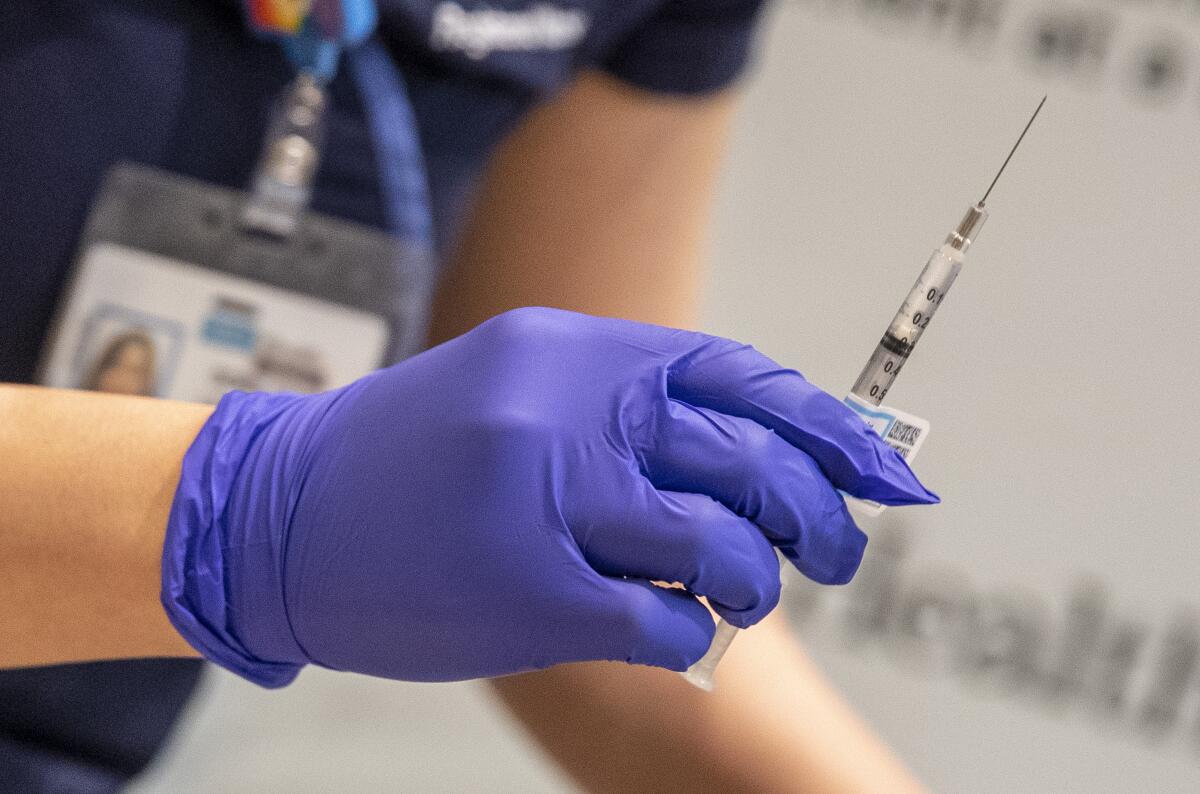California COVID-19 vaccine rollout hit with software system problems

- Share via
SACRAMENTO — California’s COVID-19 vaccine rollout is being at least partially slowed by technical problems with a software program used by the state to coordinate vaccine distribution among a vast network of providers, according to local and state health officials.
The online software system, PrepMod, is a vaccine management tool used to coordinate waitlists and inventory as well as send email proof of vaccinations to patients. It is unclear how widespread the problem is, but some providers, ranging from public clinics to nursing home operators, say the system is at times limiting access to the much-needed vaccines. The software is hosted on the state’s CalVax website.
In L.A. County the problem has affected the vaccine waitlist registry and access to vaccine registration, Public Health Director Barbara Ferrer said Wednesday. Some nursing homes have also had difficulty accessing the system, Dr. Michael Wasserman, medical director of the Eisenberg Village nursing home in Reseda and past president of the California Assn. of Long Term Care Medicine, said this week.
Wasserman blamed PrepMod as well as the COVIDReadi registration site, where all California healthcare providers must enroll to receive and administer the vaccine. Both systems, he said, are “fraught with technological problems” that hamper people’s ability to sign up for vaccines and fail to provide customer service guidance.
“There are a multitude of issues with this system,” said Wasserman, noting that it took his facility about a week and a half to receive its vaccine allotment. “We should have been able to pick it up the first day. ... We really need to streamline the process so facilities aren’t running in circles to get approved to get their vaccines.”
The snafus could at least partially explain why the state’s vaccination rollout has been slowed. So far, about 652,120 of more than 2 million doses that were shipped to the state have been administered, according to state public health officials.
California Department of Public Health officials declined to detail the extent of the software problems, but said they have received complaints from “some” local health departments.
“CDPH has been working with the vendor to work on finding solutions,” the department said this week.
The software was designed in Maryland and has been used by several states.
State officials are hoping to ramp up vaccine distribution dramatically.
On Friday, Gov. Gavin Newsom set an ambitious target of vaccinating an additional 1 million people over the next nine days. But he offered few new details in Friday’s budget proposal indicating how the state would spend the estimated $372 million he says is needed to improve vaccine rates.
Newsom said the state is ramping up efforts to ensure that those who qualify for a vaccine get it quickly, admitting the state’s effort to distribute the lifesaving supplies has been “not good enough.”
“I would expect — and you should expect — that we are going to see a substantially higher number of vaccines administered in the coming days and coming weeks,” said Newsom, later adding: “Hold me accountable.”
The state eased restrictions on who qualifies for vaccinations to help speed up the rate at which local health departments and providers administer the Pfizer-BioNTech and Moderna vaccines, a process that was created to ensure the well-off and well-connected can’t jump to the front of the line. The state’s new guidelines allow for vaccines to be offered to those in other lower-tier groups, such as teachers, childcare workers and people over the age of 75 if there is a risk of the vaccine expiring.
The state’s effort to quickly ramp up the number of people vaccinated comes as the California Hospital Assn. said Friday that the surging infection rates are expected to result in a tsunami of patients needing care at hospitals that are already stretched to their limit.
Software problems also hampered the state’s virus testing program last year. The data collection system for testing results, called CalREDIE, suffered several breakdowns that led to to hand counts of results and unreliable infection rate information.
“PrepMod and CalReadi are interim solutions.” CDPH said. “We recognized that they were imperfect fits for what we were trying to do.”
The department said it is developing new systems.
Ferrer acknowledged Wednesday that “there have been some hiccups this week” at community vaccination sites, many stemming from issues related to PrepMod’s scheduling system.
State officials are “working hard to resolve those issues,” she said, apologizing both to those staffing the sites and those who have run into delays getting their shots.
“We’re hoping that by next week there aren’t such long waits for folks who are healthcare workers trying to get vaccinated,” she said, noting that the county has implemented a backup system due to the problems with the state system.
Ferrer said Tuesday during the county’s Board of Supervisors meeting that software problems were making it difficult to access the vaccine registry waitlist, which would be accessed during a vaccine surplus.
Shalby reported from Los Angeles, Gutierrez from Sacramento. Times staff writer Luke Money contributed to this report.
More to Read
Sign up for Essential California
The most important California stories and recommendations in your inbox every morning.
You may occasionally receive promotional content from the Los Angeles Times.












